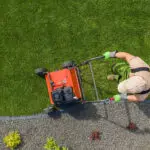Most homeowners know the effort and dedication it takes to maintain a healthy green lawn. It’s a year-round effort, especially in times of the impact of drought on your lawn. Lack of rainfall and heatwaves can make just keeping the grass alive a struggle.
The good news is there are many environmentally responsible things you can do before, during, and after a drought to keep your lawn in good health throughout the year.
Recognizing the signs of drought
Wilting grass is one of the earliest indications of dehydration. Another early warning is footprints and lawnmower tracks left on the lawn; properly hydrated grass should spring right back into place.
As the drought continues, grass changes colors from green to blueish, and finally without water, to brown. Brown doesn’t always mean the grass is dead though; it turns brown when in a dormant state to conserve moisture and nutrients for the roots. Areas in direct sunlight typically go dormant faster, with shaded areas and sections with better irrigation taking longer.
How to distinguish between billbugs and drought
The features of a billbug infestation can be mistaken for drought to the inexperienced eye. To further complicate things, billbugs are most active during high summer, and often coincide with drought. Fortunately there are some simple ways to tell them apart.
With billbugs, the brown patches tend to be random spots, spreading wherever larvae feed. If you pull on a brown patch and it comes up without resistance, that’s a sign that billbug larvae have eaten the roots. With drought, the roots remain intact.
Drought is already stressful enough for your lawn; it’s best to treat any infestations as soon as possible during the impact of drought on your lawn.
Take preventative measures of the impact of drought on your lawn
The best defense against a potential dry spell is to start lawn care early, in the springtime. Once new growth has reached around 2 to 3 inches tall, use normal lawn care techniques during the impact of drought on your lawn. These include:
Fertilization – One of the best ways to provide necessary nutrients to deficient soil. Fertilizing promotes overall growth and a strong root system capable of withstanding harsh conditions.
Watering – A healthy lawn needs around 1 to 1.5 inches of water per week, whether from rain or an irrigation system. This keeps the roots, rhizomes, and crown alive and ready to continue on in the coming fall.
Weed Control – Get rid of weeds early to prevent them from hogging essential moisture and nutrients during a drought. It’s less stressful on the surrounding lawn to remove them during good conditions.
Insect Control – Some insects can harm the grass and leave it unprepared for a sustained drought. Keep a close eye for any signs of infestation and take action early-on to minimize damage.
Aeration – Aeration loosens compacted soil by creating small holes to allow for better water and nutrient absorption. The result is stronger roots and increased circulation throughout the soil.
Tips for minimizing damage and the impact of drought on your lawn
With water conservation efforts in place and no signs of the drought letting up, keeping your lawn alive will require a proactive approach. Here are some tips:
Mowing – It’s better to mow less often and raise the blade height. Taller grass (around 3 inches) encourages deeper, stronger roots, and locks in moisture by providing shade for the soil. Avoid mowing dormant grass altogether.
Watering – With water shortages, it’s important to make use of every drop. Deeper, less frequent irrigation is the key. Schedule between 4am to 8am, when the sun and temperature is low to reduce evaporation.
Fertilization – It’s recommended to avoid fertilizing during droughts. Without enough water, it won’t be as effective and can actually cause more harm. The fertilizer salts draw moisture out of the roots at the worst time possible.
Dormant grass – Dormant grass only needs around half an inch of water every two weeks to maintain itself. Too much water risks waking it early and wasting resources. Reduce foot traffic and mowing to prevent further stress.
Mulching – A layer of mulch gives protection from the heat and helps retain moisture. Grass clipping from mowing are a healthy, free option. Spread it evenly around the lawn for best results.
Assess the damage and after-care
With the drought coming to an end, it’s time to assess the damage and the impact of drought on your lawn. A brown lawn isn’t pretty, but luckily most grass types are quick to recover back to good health with a couple weeks of normal precipitation.
Watering – With water restrictions dropped, take the opportunity to return to a normal watering schedule. Your grass will gladly absorb it. Remember to water extra early to reduce evaporation.
Reseeding – Where the grass has died, consider reseeding with more drought-resistant grass types. Kentucky bluegrasses are an excellent option and well-adapted to deal with heat and water shortages.
Fertilization – Apply fertilizer two or three weeks post-drought to replenish much needed nutrients in the soil. Confirm that no further dry spells before putting it down.
Weeding – Once the grass has recovered and matured, treat for any weeds to give it its best shot at surviving the upcoming winter. Mulching is an effective way of keeping the weeds away.
Drought is becoming more and more common throughout the state of Idaho. Thankfully, a healthy lawn is possible year-round with a little bit of planning and effort. If you’re a home or business in Ada or Canyon County, consider Lawn Master for your lawn care needs. Contact us today at (208) 989-9261.



